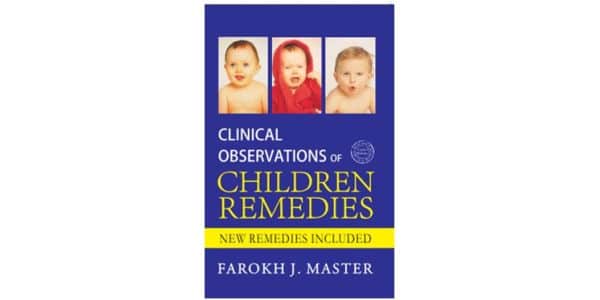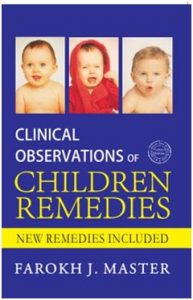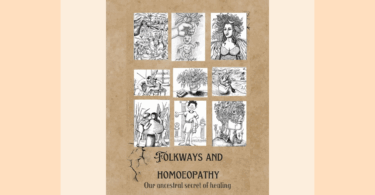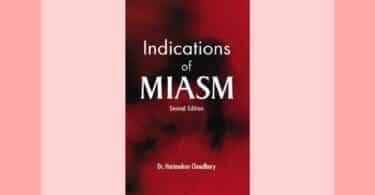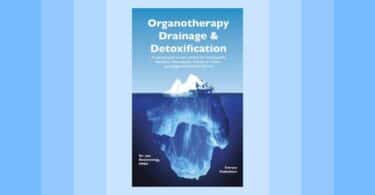Clinical Observations of Children’s Remedies
Author: Dr. Farokh Master
Edition: 2nd edition
ISBN: 90-74456-11-1
Publisher: B. Jain Publishers
Dr. Farokh Master has been a well-known name in the field of homeopathic Medicine for the last three decades. He has a phenomenal knowledge of homeopathic principles which he can correlate very well with modern medicine. Apart from being a great physician, Dr. Master is also a great teacher who has guided numerous young homeopaths towards the correct path in homeopathy. In fact, I would not like to call him a “Teacher” in Homeopathy, but I would like to call him a “Master” in Homeopathy.
Dr. Master has written numerous books on homeopathy and all of them are unique in their own way, covering various aspects of homeopathy from Medicine to Repertory, from Materia Medica to Organon of Medicine. One of his masterpieces is Clinical Observation of Children’s Remedies, which I am going to review in this article.
Pediatric practice forms a major part of clinical practice for any homeopath. Parents prefer giving homeopathic medicines to their children as these medicines have few side effects and are easy to give to children. For any homeopath to be successful, he or she needs to show success in children’s cases. To achieve this success, Dr. Master’s book “Clinical Observation of Children’s Remedies” in an infallible companion.
The book begins by eliciting important points in the behaviour of children of different age groups, which a homeopathic physician must observe keenly in order to elicit the physical and emotional state of the child. This is followed by one of the most important parts of the book, “The Art and Science of Paediatrics”. In this section, Dr. Master points out the qualities which a homeopath needs for being a successful paediatric physician, followed by a detailed methodology of homeopathic case taking in paediatrics. Dr. Master also mentions certain important observations in new born, infants and toddlers which he has encountered in his many years of practice. This part is very useful for any homeopath, as it also contains the important remedies present in those observations, e.g.
- Types of crying
- Soft, pitiful cry:
- Irritable cry: Calc, Cham, Ip, Sep, etc.
- Sobs a lot: Cham, Cupr, Hell, Hyos, Ign, Lyc, Op, Stram, etc.
- Whines and whimpers incessantly: Bell, Borax, Bry, Cham, Cina, Cupr, Nux-v, Rheum, Stram.
The next section of the book is the Materia Medica. There are 76 remedies listed in the second edition of the book. The symptoms listed under the remedies are based purely on the vast clinical experience of Dr. Master from his personal practice in his own clinic and different hospitals. Throughout the materia medica, various observations and helpful references are listed which are of utmost help to any homeopathic physician who is managing children’s cases.
Each remedy is divided into two main parts:
- Identifying Features
- Other Important Symptoms
Each of these two main parts is further sub-divided into mental and physical symptoms. This format makes it very easy for a homeopathic physician or a student to understand a remedy in its complete detail. Lots of clinical and pathological data, which includes physical examination, X-rays, CT scans, MRI, routine urine and stool examination, complete blood count, sputum examination, blood culture, are also mentioned in the remedies wherever applicable. The symptoms listed in bold font are those symptoms that can help to identify only that remedy and no other remedy. The symptoms in plain text are important symptoms of the remedy that can further support the bold ones, and make the selection of the remedy much more reliable.
Another useful aspect of the book is that there are similar drugs mentioned within brackets wherever possible. Detailed differentiation between similar remedies in different clinical conditions is done in tabular forms.
The best use of this book for any homeopathic physician is to carry it as a bedside companion and try to match the findings of the case i.e. symptoms, clinical data, pathological findings, laboratory data, of the patient with the clinical observations mentioned in the book. Further questioning of the parents can also be done to confirm the remedy as per the set of questions listed in the section of case taking.
I would highly recommend this book to every student and practitioner of homeopathy, who is seriously interested in pediatric practice. It is an excellent and honest book that can guide the reader to be a successful pediatric practitioner.

